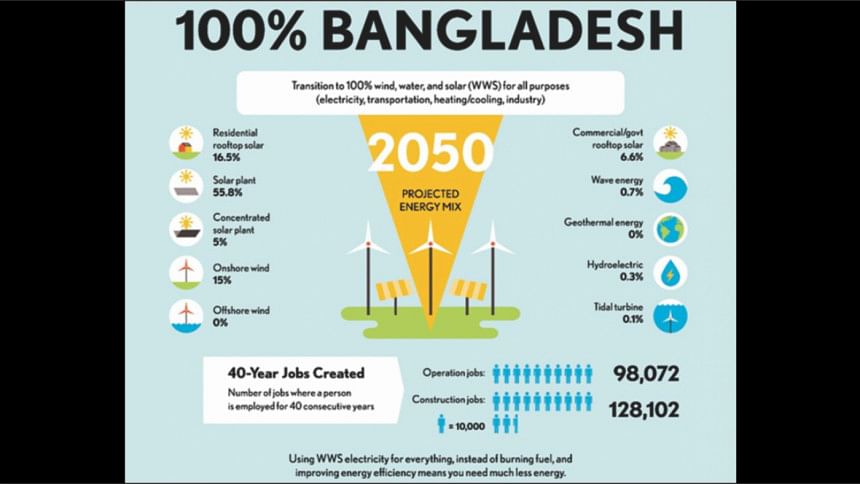Breaking free from fossil fuels

It came as no surprise when the National Oceanic and Atmospheric Administration (NOAA) last week announced that the earth's global temperatures in March 2016 were the most abnormally warm on record for any month in the 137 years of its record keeping and 1.22 degree Celsius above average in the 20th century. Can you guess when this record was last broken?
The March Anomaly is the second month in a row that this remarkable feat has occurred. The world is having one of its hottest years already. The scorching global warming has also been felt by Bangladeshis, as can be observed from last week's mild heat wave across Rajshahi and Khulna.
Climate change is a real threat and Bangladesh is at the very forefront of that change. The Intergovernmental Panel on Climate Change has warned that rising sea levels will wipe out more cultivated land in Bangladesh than anywhere in the world. And then there's the threat of mass migration, which is already a reality. It's being estimated that by 2050, around 15 to 40 million people will migrate from their native place.
The primary human activity affecting the amount and rate of climate change is greenhouse gas emissions from the burning of fossil fuels. It is important to mention here that Bangladesh's emission, or carbon footprint, in respect to the rest of the world is insignificant. Nevertheless, over the last couple of years, we have experienced firsthand the consequences of severe pollution thanks to our own faults.
Bangladesh's energy, agriculture and transportation sector depend on fossil fuels. With subsidies on fossil fuel, the transition to renewable energy is as slow as it can get. The Power Division has targets to increase the renewable energy generation up to 10 percent of the total electricity by 2020.
But why depend on fossil fuel when people are welcoming renewable sources? According to the government-run Infrastructure Development Company Limited (IDCOL), around three million solar home systems have been installed till the first quarter of 2014 under their programme, with a rate of 50 to 60 thousand installations on average in a month. That covered 10 percent of the rural off-grid population. IDCOL has a target to finance six million solar home systems by 2017. A comparison of energy mix between 2008 and 2015 will also show that renewable energy sources are getting momentum.
Subsidies on oil price have gone down, but its use has not. Tk. 90 billion has been allocated for power subsidy in this year's budget, which will go to the Bangladesh Power Development Board. This used to be around Tk. 81.4 billion in 2012. Do keep in mind the drop in the price of oil and also the fact that the majority of the electricity is generated from oil-based plants. The Power Development Board purchases electricity from rental and quick rental power plants at prices ranging between Tk. 13 and Tk. 23 per unit and sells the electricity to consumers at an average of Tk. 6.5 per unit, which is a net negative for the government.
The International Energy Agency (IEA) published a special edition of World Energy Outlook, prior to the Paris Summit, where they proposed a five-point strategy that could deliver a peak in energy-related emissions by 2020. It included points like progressively reducing the use of the least-efficient coal-fired power plants and banning their construction; increasing investment in renewable energy technologies in the power sector; and gradual phasing out of fossil-fuel subsidies to end-users by 2030. The overall idea is to break free from fossil fuels and create 100 percent renewable dependence, which is not unrealistic.
Researchers from Stanford University analysed energy roadmaps for 139 countries and calculated the energy that would be needed to meet the demands for household electricity, industry, agriculture, transportation, heating and cooling. They examined the best renewable energy sources for different countries to determine the perfect source for each country that would enable it to go completely renewable by 2050. According to the report, 100 percent is scientifically doable. Also the report of the International Renewable Energy Agency points out that the transition to a sustainable energy future by 2030 is technically feasible and economically viable. But no current policy keeps us anywhere near this 100 percent goal by 2030 or 2050 while the use of fossil fuels is crippling the environment and heritage sites, threatening biodiversity and human existence.
The Stanford study also concludes with a statement that is also true for Bangladesh: "The study finds that the conversion to Wind, Water and Solar (WWS) is technically and economically feasible. The main barriers are still social and political."
The Bangladesh government states that energy demand means there is no alternative but to generate more power from fossil fuels, as they plan to establish 25 coal-fired power plants by 2022, adding 23,692 MW to the electricity output. Of the total, 16 will be built by the public sector and nine by the private sector.
So, with subsidies being constant and with new plans to fund coal-fired plants, it is unlikely that Bangladesh will be able to break free from fossil fuels in the near future, even though its solar installations rate is the world's fastest. The government's long term plan to promote renewable energy is not adequate, and the target has changed frequently since 2011-12, after the inclusion of the nuclear energy plan.
We suffer, and yet we fail to take steps to ensure that we are not the cause of further environmental degradation. The growth of a country depends on energy, but not at the cost of our environment. Rather than going for the easy solution, we need to take a step back and plan our actions, so that our future is not affected.
The writer is a Program Assistant for Centre for Teaching Excellence at the University of South Carolina.
Twitter: @prsanyal

 For all latest news, follow The Daily Star's Google News channel.
For all latest news, follow The Daily Star's Google News channel. 








Comments